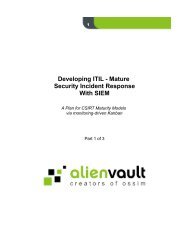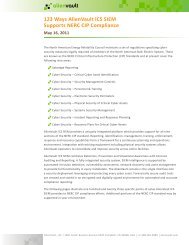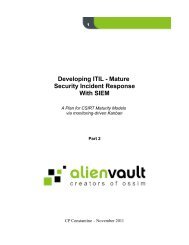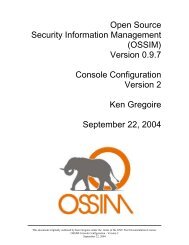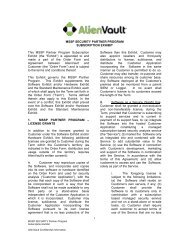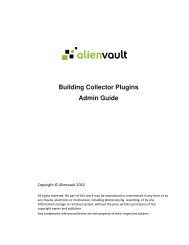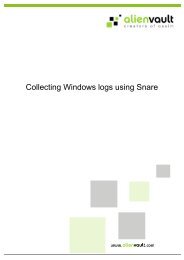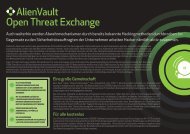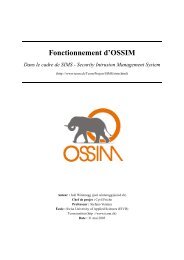ossim - AlienVault
ossim - AlienVault
ossim - AlienVault
Create successful ePaper yourself
Turn your PDF publications into a flip-book with our unique Google optimized e-Paper software.
OSSIM<br />
Open Source Security Information Management<br />
General System Description<br />
Wednesday, 26 November 2003 Version: 0.18
Team<br />
The current development team for the project is:<br />
Dominique Karg, <br />
Jesús D. Muñoz, <br />
David Gil, <br />
Fabio Ospitia <br />
Santiago González, <br />
Julio Casal, <br />
Technical Director<br />
Documentation<br />
Development<br />
Development<br />
Software Integration<br />
Coordinator<br />
2
Index<br />
Foreword ....................................................................................................................... 4<br />
1. Introduction ............................................................................................................ 5<br />
1.1. Introduction .................................................................................................... 5<br />
1.2. What is OSSIM? ............................................................................................ 6<br />
1.3. Open Source Infrastructure for Security Monitoring ...................... 7<br />
2. The Detection Process ........................................................................................ 8<br />
3. Functionality ......................................................................................................... 11<br />
3.1 Pattern Detectors......................................................................................... 11<br />
3.2 Anomaly Detectors ...................................................................................... 12<br />
3.3 Centralization and Normalization .......................................................... 13<br />
3.4 Prioritization................................................................................................... 14<br />
3.5 Risk Assessment........................................................................................... 15<br />
3.6 Correlation ...................................................................................................... 16<br />
3.6.1 Correlation Model................................................................................. 16<br />
3.6.2 Correlation Methods............................................................................ 17<br />
3.6.3 Levels of Correlation........................................................................... 20<br />
3.7 Monitors........................................................................................................... 23<br />
3.8 Forensic Console .......................................................................................... 24<br />
3.9 Control Panel ................................................................................................. 24<br />
4. Architecture .......................................................................................................... 26<br />
4.1. General Architecture ................................................................................. 26<br />
4.2 Data Flow ........................................................................................................ 27<br />
4.3 Distribution Architecture ........................................................................... 29<br />
Contact......................................................................................................................... 30<br />
3
Foreword<br />
The goal of OSSIM is to fill a gap that we see in our daily needs as security professionals.<br />
Considering the important technological advances of recent years that have made tools with<br />
capacities such as those of IDS available to us, we are surprised that it is so complex from a<br />
security standpoint to obtain a snapshot of a network as well as information with a level of<br />
abstraction that allows practical and manageable monitoring.<br />
In developing this project, our primary intent is to rectify this situation with a functionality that<br />
can be summarized in a single word:<br />
CORRELATION<br />
Correlation means the ability to view all events in all systems in one place and in the same<br />
format, and from this priveleged vantage point compare and process the information, thereby<br />
allowing us to improve detection capabilities, prioritize events according to the context in which<br />
they occurred, and monitor the security situation of our network.<br />
The idea of correlation is also implicit in the vision of our project in the sense of bundling and<br />
integrating products. Within the general framework of OSSIM, we want to include a number of<br />
magnificent products developed in recent years that create new possibilities when their<br />
functionalities are interrelated.<br />
In developing OSSIM, we encountered new needs that helped us improve the precision of our<br />
system and develop the functionality that is now a core element of OSSIM:<br />
RISK ASSESSMENT<br />
In each case, in order to decide whether or not to perform an action we evaluate the threat<br />
represented by an event in relation to certain assets, keeping in mind the reliability of our data<br />
and the probability the event will occur.<br />
This is where our system becomes more complex, and we must therefore be able to implement<br />
a security policy, a network inventory, a real-time risk monitor—all configured and managed<br />
within a single framework... In any case, we cannot let complexity keep us from achieving our<br />
objective: product integration.<br />
Consequently, this project is quite ambitious; it inherits all the functionalities and impressive<br />
development progress made by an entire community of experts, while our role is that of mere<br />
integrators and organizers.<br />
In this sense, our project aspires to exemplify the capacity of the open source movement to<br />
grow on its own and contribute innovative solutions in specific sectors like network security, in<br />
which free-software solutions contribute another valuable functionality: auditability of the<br />
systems we install on our network.<br />
4
1. Introduction<br />
1.1. Introduction<br />
We developed this project in response to a scenario that has repeated itself over and over in<br />
recent years:<br />
In the event an intrusion succeeds, once the perimeter defenses are cleared dozens of<br />
machines are compromised. There is a flow of permanent and durable connections for several<br />
hours, anomalous connections that establish paths completely contrary to what is acceptable.<br />
External processes create a bridge to enter the internal network, where more machines are<br />
compromised, one after the other, following more and more anomalous, and dangerous, paths.<br />
The users and administrators of the victim organization who are working on those machines<br />
never notice anything strange at the time, and they rarely identify the attack after the fact.<br />
Although somewhat exaggerated and comical, a real world analogy would be the thief that<br />
breaks into an office in broad daylight kicking in any one of its doors, walks right past people<br />
working at their desks, strolls into the filing room, photocopies the documentation of interest,<br />
finds a safe, and starts pounding away with a hammer without a second thought. Meanwhile, all<br />
the employees just sit there, engrossed in their work...<br />
Something is wrong with how attacks on company networks are detected. We apparently have<br />
the right technology; we have the ability to detect extremely specific events using intrusion<br />
detection systems. Yet we are not able to monitor all the alerts they send due to two reasons:<br />
• volume<br />
• unreliability<br />
In other words, we get too many alerts, and they are not reliable. We get too many false<br />
positives.<br />
We receive information that is very detailed but partial, and that does not lend itself to<br />
abstraction. We are not able to detect attacks defined by more complex behavior; our second<br />
problem is false negatives.<br />
5
1.2. What is OSSIM?<br />
OSSIM is a distribution of open source products that are integrated to provide an infrastructure<br />
for security monitoring.<br />
Its objective is to provide a framework for centralizing, organizing, and improving detection and<br />
display for monitoring security events within the organization.<br />
Our system will include the following monitoring tools:<br />
a. Control panel for high-level display<br />
b. Risk and activity monitors for mid-level monitoring<br />
c. Forensic console and network monitors at the low level<br />
These tools utilize new capabilities developed in SIM post-processing, whose objective is to<br />
improve detection reliability and sensitivity:<br />
a. Correlation<br />
b. Prioritization<br />
c. Risk assessment<br />
Post-processing in turn makes use of the preprocessors, a number of detectors and monitors<br />
already known to most of the administrators that will be included in our distribution:<br />
a. IDS (pattern detectors)<br />
b. Anomaly detectors<br />
c. Firewalls<br />
d. Various monitors<br />
Finally, we need an administrative tool that configures and organizes the various modules, both<br />
external and native, that comprise OSSIM. That tool is the framework, which allows us to<br />
inventory assets; to define the topology, a security policy, and correlation rules; and to link up<br />
the various integrated tools.<br />
6
1.3. Open Source Infrastructure for Security Monitoring<br />
Solution vs. Product<br />
OSSIM is not a product; it is a solution, a system personalized for the needs of each<br />
organization and created by the interconnection and integration of various specialized modules.<br />
In our solution, the following elements and definitions are just as important as the code:<br />
a. The architecture<br />
b. Correlation models and algorithms<br />
c. The definitions of environment and framework<br />
d. The definition of the model for perimeter security management<br />
e. The map and procedures for auditing detection capacity<br />
We are developing this project in the open source tradition both to make the code available for<br />
improvement and to generate discussion about and awareness of these models and algorithms.<br />
Open Architecture<br />
OSSIM has an open monitoring architecture and therefore integrates many open source<br />
products, always with the intention of abiding by the standards and practices of the open source<br />
community (which we believe will become the standards for monitoring solutions in all<br />
environments).<br />
Integrated Solution<br />
As an integrated solution, OSSIM offers tools and functionality for monitoring at any level, from<br />
the lowest (detailed IDS signatures, intended for the security technician) to the highest (a<br />
control panel designed for strategic management), and everything in between (forensic<br />
consoles, correlation levels, asset and threat inventories, and risk monitors).<br />
Open Source Software<br />
OSSIM was conceived as an integration project, and our intent is not to develop new<br />
capabilities but to take advantage of the wealth of free software “gems,” programs developed<br />
and inspired by the best programmers in the world (including snort, rrd, nmap, nessus, and<br />
ntop, among others), by integrating them within an open architecture that preserves all their<br />
value and capabilities. Our solution will be responsible for integrating and interrelating the<br />
information provided by these products.<br />
By virtue of being open source projects, these tools have been tested and improved by dozens<br />
or hundreds of thousands of installations all over the world, and consequently they have<br />
evolved into robust, highly tested, and therefore reliable elements.<br />
The fact that they are open source means that anyone who wants to can audit them; these open<br />
source tools are above suspicion of harboring back doors.<br />
7
2. The Detection Process<br />
If we had to summarize what we are trying to accomplish or what our project is about in a single<br />
phrase, it would be this: “Improve Detection Capability”<br />
In this section we will introduce the concepts related to network detection that will be developed<br />
throughout the document.<br />
Detectors<br />
We define a detector as any program capable of processing information in real time, usually low<br />
level information like traffic or system events, and capable of sending alerts when previously<br />
defined situations arise.<br />
These situations can be defined in either of two ways:<br />
1. By patterns, or rules defined by the user<br />
2. By anomaly levels<br />
Detection Capability<br />
Detection capabilities have improved enormously in recent years, the best example being IDSs,<br />
which are capable of detecting patterns at the most detailed level.<br />
In order to discuss the capability of a detector, we will define it using two variables:<br />
• Sensitivity or the capability our detector has for extensive and complex analysis in<br />
identifying possible attacks.<br />
• Reliability, which, as its name suggests, is the level of certainty provided by our detector<br />
when we receive warning of a possible event.<br />
Inadequate Detection<br />
Throughout this document we will see that despite advances in the scope of detection systems,<br />
their capabilities are still far from acceptable.<br />
Because of detector inadequacy in these two areas, we are confronted with the two main<br />
problems encountered today:<br />
• False positives. Detector unreliability or alerts that actually do not correspond to real<br />
attacks.<br />
• False negatives. Inadequate detection means that attacks go unnoticed.<br />
8
The following table summarizes these ideas:<br />
I. Detector capability<br />
Reliability<br />
Sensitivity<br />
The Detection Process<br />
Property<br />
The level of certainty provided<br />
by our detector when we<br />
receive warning of a possible<br />
event<br />
The capability our detector has<br />
for extensive and complex<br />
analysis in locating possible<br />
attacks<br />
Result in its absence<br />
False Positives<br />
False negatives<br />
We will refer to the global process developed by the SIM as the detection process, including the<br />
organization’s various detectors and monitors as well as those executed by the system to<br />
process this information.<br />
The detection process normally involves three well-defined phases:<br />
• Preprocessing: Detection itself, in which detectors generate alerts and information is<br />
consolidated before being sent.<br />
• Collection: All the information from these detectors is sent and received at a central<br />
location.<br />
• Post-processing: What we do with the information after we have it all centralized.<br />
Post-processing<br />
Preprocessing and collection are traditional capabilities and do not contribute anything new to<br />
our solution. But in post-processing, once we have all the information in one place, we can<br />
implement mechanisms that will improve detection sensitivity and reliability. We increase the<br />
complexity of the analysis by including methods to discard false positives or on the other hand<br />
prioritize or discover more complex patterns that our detectors have overlooked.<br />
In OSSIM we use three post-processing methods:<br />
1. Prioritization: We prioritize alerts received using a contextualization process developed by<br />
defining a topological security policy in combination with the inventory of our systems.<br />
2. Risk assessment: Each event is evaluated in relation to its associated risk, in other words,<br />
in proportion to the assets at risk, the threat represented by the event, and the probability it is<br />
real.<br />
3. Correlation: We analyze a collection of events to obtain more valuable information.<br />
9
The following figure shows how the properties mentioned above are affected by these<br />
processes:<br />
II. Post-processing<br />
Prioritization<br />
Risk assessment<br />
Correlation<br />
Processing<br />
Assess the threat by<br />
contextualizing an event<br />
Assess the risk in relation<br />
to the value of assets<br />
Compare various events<br />
to obtain more valuable<br />
information<br />
Effect<br />
Improves reliability<br />
Improves reliability<br />
Improves reliability, sensitivity,<br />
and abstraction<br />
So after processing them, our system will use the alerts provided by detectors to produce what<br />
will be referred to in this document as alarms.<br />
An alarm will usually be the result of various alerts and have a higher level of abstraction that<br />
allows us to identify more complex patterns—and it will provide better reliability.<br />
The Detection Map<br />
With the goal of defining detection capability, OSSIM will develop a detection map, which will<br />
involve categorizing the possibilities in the detection of attacks and security events.<br />
Auditing Detection Capability<br />
Using this detection map we will be able to define a new auditing method that will allow us to<br />
measure the situation and needs of an organization in relation to the effectiveness of its<br />
detection systems when an attack is in place.<br />
This perspective is very different from the traditional audit or intrusion test, since we are<br />
interested not in locating security failures but in the capability to detect the eventual exploitation<br />
of these failures.<br />
In this project we will therefore develop a Detection Capability Auditing Procedure with which we<br />
will provide a mechanism for assessing an organization’s situation in relation to its capacity for<br />
detecting attacks.<br />
10
3. Functionality<br />
In order to understand what OSSIM offers we can define the functionality of the system using a<br />
simplified, graphical form with the following nine levels:<br />
We discuss each of these levels below to help give a practical description of our system:<br />
3.1 Pattern Detectors<br />
Most traditional detectors operate using patterns, the best example of which is the IDS or<br />
intrusion detection system, which is capable of detecting patterns defined using signatures or<br />
rules.<br />
There is another class of pattern detectors that are included in most devices like routers and<br />
firewalls, and they are capable of detecting, for example, port scans, spoofing attempts, and<br />
possible fragmentation attacks.<br />
We also have detectors for security events within an operating system. They are capable of<br />
sending alerts for possible security problems, and they almost all include their own logger, like<br />
syslog for UNIX.<br />
Any element in the network, such as a router, a work station, a firewall, etc., has some capacity<br />
for detection. In our system, we are interested in collecting events from all critical systems in<br />
order to achieve one of our principle objectives: a comprehensive view of the network.<br />
11
3.2 Anomaly Detectors<br />
The ability to detect anomalies is more recent than that for patterns. In this case we do not have<br />
to tell the detection system what is good and what is bad; it can learn on its own and alert us<br />
when behavior deviates enough from what it has learned is normal.<br />
Since the two processes work in opposite ways, this new functionality provides a point of view<br />
that is both different and complementary to pattern detection.<br />
Anomaly detection can be especially useful for preventing, for example, perimeter attacks,<br />
which are one continuous anomaly: in the direction of the communications and the path they<br />
define, in the flow of data, in their size, duration, time, content, etc.<br />
This technique provides a solution—until now beyond reach—for controlling access of privileged<br />
users, as in internal attacks by, for example, disloyal employees, in which no policies are<br />
violated and no exploits carried out. Yet they represent an anomaly in the use and manner of<br />
use of a service.<br />
Now let's look at some other examples in which these detectors would be useful:<br />
• A new attack for which there still are no signatures could produce an obvious anomaly<br />
yet circumvent pattern detection systems.<br />
• A worm that has been introduced into the organization, a spamming attack, and even<br />
the use of P2P programs would generate a number of anomalous connections that are<br />
easy to detect.<br />
• We could likewise detect:<br />
o Use of services that is abnormal in origin and destination<br />
o Use at abnormal times<br />
o Excess use of traffic or connections<br />
o Abnormal copying of files on the internal network<br />
o Changes in a machine's operating system<br />
o Etc.<br />
We might think that, as an undesirable byproduct, these detectors will generate a number of<br />
new alerts, amplifying our signal and making our problem worse (our objective is to limit the<br />
number of alerts). However, if we take them as additional information that complements the<br />
traditional pattern alerts, we will be able to evaluate and therefore differentiate those that could<br />
result in a higher risk situation.<br />
12
3.3 Centralization and Normalization<br />
Normalization and centralization (or aggregation) are aimed at unifying security events from all<br />
critical systems throughout the organization in a single format on just one console.<br />
All security products normally have a capacity for centralized management using standard<br />
protocols; hence, aggregation is simple using these protocols. In OSSIM we attempt to avoid<br />
regular use of agents and instead use forms of communication that are native to systems.<br />
Normalization requires a parser or translator familiar with the types and formats of alerts coming<br />
from different detectors. We will need to organize the database and adapt the forensic console<br />
in order to homogenize processing and display of all these events.<br />
That way we will be able to observe all security events for a particular moment in time—whether<br />
they come from a router, a firewall, an IDS, or a UNIX server—on the same screen and in the<br />
same format.<br />
When we have all network events centralized in the same database, we achieve a considerably<br />
comprehensive view of what’s going on throughout the network, which, as we will see shortly,<br />
allows us to develop processes that enable us to detect more complex and widely dispersed<br />
patterns.<br />
13
3.4 Prioritization<br />
The priority of an alert should depend on the topology and inventory of the organization’s<br />
systems. The reasons are quite clear, as demonstrated by the following examples:<br />
a. If a machine running the UNIX operating system and Apache web server receives<br />
an alert about an attack on Microsoft IIS, the alert should be deprioritized.<br />
b. If a user makes a suspicious connection to a server, the system should:<br />
o Give it maximum priority if the user is external to the network and attacking<br />
the client database.<br />
o Give it low priority if the user is internal to the network and attacking a<br />
network printer.<br />
o Discard it if the user is someone who normally tests development servers.<br />
By prioritization we mean the process of contextualization, in other words, the evaluation of an<br />
alert’s importance in relation to the organization’s environment, which is described in a<br />
knowledge base for the network comprised of:<br />
• An inventory of machines and networks (identifiers, operating systems, services,<br />
etc.)<br />
• An access policy (whether access is permitted or prohibited, and from where to<br />
where)<br />
To perform these tasks (as in risk assessment, as explained in the following section), we have a<br />
framework in which we can configure the following:<br />
1. Security policy, or assessment of asset-threat pairs according to topology and data<br />
flow<br />
2. Inventory<br />
3. Asset assessment<br />
4. Risk assessment (prioritization of alerts)<br />
5. Assessment of the reliability of each alert<br />
6. Alarm definition<br />
Prioritization is one of the most important steps in filtering alerts received by detectors and<br />
should be executed using a continuous process of fine-tuning and feedback from the<br />
organization.<br />
14
3.5 Risk Assessment<br />
The importance given to an event depends on these three factors:<br />
Intrinsic Risk<br />
a. The value of the assets associated with the event<br />
b. The threat represented by the event<br />
c. The probability that the event will occur<br />
These three factors are the building blocks for the traditional definition of risk: a measure of the<br />
potential impact of a threat on assets given the probability that it will occur.<br />
Traditionally risk assessment is concerned with intrinsic risks, or latent risks, in other words,<br />
risks that an organization assumes by virtue of both the assets it possesses for the purpose of<br />
developing its business and circumstantial threats to those assets.<br />
Immediate Risk<br />
In our case, due to real-time capabilities we can measure the risk associated with the current<br />
situation in immediate terms.<br />
In this case the measurement of risk is weighted by the damage it would produce and the<br />
probability that the threat is occurring in the present.<br />
That probability, which is a derivative of the imperfection of our sensors, turns out to be nothing<br />
more than the degree of reliability of our sensors in detecting the potential intrusion-in-progress.<br />
By immediate risk we mean the state of risk produced when an alert is received and assessed<br />
instantaneously as a measure of the damage an attack would produce, weighted by the<br />
reliability of the detector that made the report.<br />
OSSIM calculates the immediate risk of each event received, and this will be the objective<br />
measure we use to assess the event's importance in terms of security. We assess the need to<br />
act using this measure only.<br />
Our system likewise includes a risk monitor (described below) that assesses the risk<br />
accumulated over time of networks and groups of machines related to an event.<br />
15
3.6 Correlation<br />
We define the correlation function as an algorithm that executes an operation on input data and<br />
returns output data.<br />
We must consider the information collected by our detectors and monitors to be specific yet<br />
partial; it illuminates only small areas along the spectrum defined by all the information we<br />
would really like to have.<br />
We can think of correlation as the ability to take advantage of these systems and, using a new<br />
layer of processing, fill in more areas along that infinite spectrum of all possible information<br />
about a network.<br />
If we got carried away, this idea could lead us to try to install one single system with a detector<br />
that can gather all possible information about the network, but it would require a display that<br />
shows absolutely everything in one place and almost limitless memory and storage capacity.<br />
Therefore, correlation systems merely supplement the inadequate sensitivity, reliability, and<br />
limited range of our detectors.<br />
Input and Output<br />
In simple terms, our architecture has two clearly defined elements that provide information to its<br />
correlation functions:<br />
• Monitors, which normally provide indicators<br />
• Detectors, which normally provide alerts<br />
The output will also be one of these two elements: alerts or indicators. Our correlation functions<br />
become new detectors and monitors.<br />
3.6.1 Correlation Model<br />
The OSSIM correlation model has ambitious objectives:<br />
1. Develop specific patterns for detecting the known and detectable<br />
2. Develop nonspecific patterns for detecting the unknown and the undetectable<br />
3. Provide an inference machine that can be configured using interrelated rules and that has<br />
the ability to describe more complex patterns<br />
4. The ability to link detectors and monitors recursively to create more abstract and useful<br />
objects<br />
5. Develop algorithms for displaying a general view of the security situation<br />
16
3.6.2 Correlation Methods<br />
To achieve these objectives we employ two very different correlation methods, based on the<br />
following two principles:<br />
• Correlation using sequences of events, focused on known and detectable attacks,<br />
relates the known patterns and behaviors that define an attack using rules implemented<br />
by a state machine.<br />
• Correlation using heuristic algorithms. Using an opposite approach, we implement<br />
algorithms that attempt to detect risky situations using heuristic analysis. In an effort to<br />
compensate for the shortcomings of other methods, this one detects situations without<br />
knowing or displaying the details. It is useful for detecting unknown attacks and<br />
displaying a general view of the security state for a large number of systems.<br />
3.6.2.1 Method 1: Correlation Using Heuristic Algorithms<br />
For correlation OSSIM will implement a simple heuristic algorithm using event accumulation in<br />
order to obtain an indicator or snapshot of the general security state of the network.<br />
In this process our first objective is to obtain what we defined earlier as immediate risk and<br />
subsequently a value we could call accumulated risk.<br />
This provides high level monitoring that we can use as a “thermometer” for risky situations<br />
without ever knowing any details about the characteristics of the problem.<br />
Continuing with that analogy, we will construct a sensitive thermometer that will display the total<br />
accumulated risk in a certain time frame. The thermometer will go up proportionately to the<br />
amount of events received recently and to how “hot" they are, and it will cool off as time goes on<br />
if no new events are received.<br />
This correlation method supplements correlation using sequences of events with an opposite<br />
approach—in the latter we attempt to characterize possible attacks to the highest level of detail.<br />
Consequently, the value of correlation using heuristic algorithms is twofold:<br />
CALM<br />
• It provides a quick global view of the situation.<br />
• It detects possible patterns that other correlation systems might overlook, either<br />
because the attacks are unknown or due to some shortcoming.<br />
CALM (Compromise and Attack Level Monitor) is an assessment algorithm that uses event<br />
accumulation with recovery over time. Its input is a high volume of events, and its output is a<br />
single indicator of the general state of security.<br />
This accumulation is executed for any subject on the network, including any machine, group of<br />
machines, network segment, path, etc. that we are interested in monitoring.<br />
Event Accumulation<br />
Accumulation is calculated simply by the sum of two state variables that represent the<br />
immediate risk of each event:<br />
17
• “C” or level of compromise, which measures the probability that a machine is<br />
compromised<br />
• “A” or level of attack to which a system is subjected, which measures the potential<br />
risk due to attacks launched<br />
Why separate these two variables for monitoring? First, because they characterize different<br />
situations: the level of attack indicates the probability that an attack has been launched, an<br />
attack that may or may not be successful; while the level of compromise provides direct<br />
evidence that there has been an attack and that it has been successful.<br />
Second, the importance of both variables depends on the situation of the machine. Mainly due<br />
to the exposed state of perimeter networks, which are exposed to an enormous number of<br />
attacks, most of them automated, unfortunately a high level-of-attack value is a “normal”<br />
situation. However, any sign of compromise or movement that might lead us to think there is an<br />
attacker residing in these networks should be immediately pointed out and reviewed.<br />
On the other hand, there are cases in which a machine generates anomalies within the network<br />
due to the nature of its function—such as a security scanner, a service with random passive<br />
ports, development, etc.—and these will normally have a high C and a low A.<br />
A value is assigned to the C or A variable for a machine on the network according to three rules:<br />
1. Any possible attack launched from machine 1 on machine 2 will increase the A (level of<br />
attacks experienced) of machine 2 and the C (level of compromise, or suspicious<br />
actions normally perpetrated by a hacker) of machine 1.<br />
2. When there is an attack response (a response that could indicate the attack’s success),<br />
the value of C will increase for both machines 1 and 2.<br />
3. If the events are internal, the C value will go up only for the originating machine.<br />
Accumulation Over Time<br />
Since CALM is intended for real-time monitoring, we are interested in a short-term time frame.<br />
In other words, We are interested in assessing recent events, and the algorithm should have<br />
short-term memory that places importance on the most recent events and discards the oldest.<br />
The current implementation uses a simple variable for recovery over time. The system will<br />
periodically lower the C and A levels for each machine by a constant value.<br />
18
3.6.2.2 Method 2: Correlation Using Sequences of Events<br />
The Sequences Panel<br />
The basic idea for detecting a sequence of patterns is simple: just create a list of rules like “if<br />
you receive event A and then B and then C, perform action D.”<br />
To that end we use the sequences panel, where we define lists of rules for each sequence of<br />
events that we want to define.<br />
The complexity of the panel depends on the capacity of those rules for abstraction and OSSIM’s<br />
ability to analyze a variety of input.<br />
Our panel can execute sequences with the following characteristics:<br />
• Ability to define variable origins and destinations<br />
• Accept both pattern input from detectors and indicator input from monitors<br />
• Define the priority and reliability of new alerts<br />
• Use “elastic” variables, or variables that can measure an event to define priority or<br />
reliability (e.g. total denial of service -> high priority, 50% denial -> medium priority, 15%<br />
denial -> low priority)<br />
• Recursive architecture—we can create objects by correlating rules that function as<br />
detectors or monitors in new rules<br />
19
3.6.3 Levels of Correlation<br />
The recursive nature of our model allows the creation of an almost infinite hierarchy of levels,<br />
but for the purposes of this explanation we will define a hierarchy with three levels as shown in<br />
the following diagram:<br />
Level<br />
Correlation using sequences of events<br />
3. Attack behavior<br />
2. Specific attack General activity<br />
1. Patterns Specific activity<br />
We will discuss all three levels, but out of order to facilitate explanation:<br />
Level 2.1 Specific Attack<br />
This level deals directly with detectors and monitors. We will attempt to include both signatures<br />
and activity related to concrete attacks, i.e. those with a known first and last name, exactly as<br />
identified by the detector (for example, “compromised by ftp cwd overflow”).<br />
The main objective of the specific attack level is to improve detection reliability. This means that<br />
instead of being satisfied with a possible attack signature, we look for more evidence<br />
demonstrating that the attack is either in progress or has failed.<br />
This evaluation is what will make the difference in limiting false positives and prioritizing real<br />
attacks in a security detection system, since as we have seen the reliability of an event directly<br />
affects the calculation of risk.<br />
Consider this simple example of correlation between a pattern detector and a monitor:<br />
Using a signature the IDS detects a possible denial of service attack via synflood and sends an<br />
alert triggering a query to the service monitor to see if it has experienced a drop in availability<br />
and to what degree. Consequently we can assign our alert “denial of service via synflood” a<br />
higher degree of reliability.<br />
We normally use more complex sequences in which we correlate alerts produced by signatures<br />
with the specific behavior characteristic of an attack. Now consider Trojan horse detection. We<br />
can detect various operations using IDS signatures:<br />
Connect, active, get info, access, server2client_flow, client2server_flow,<br />
response, traffic_detect<br />
20
Detection of a connect operation is probably not very useful information in and of itself. There<br />
are dozens every day in perimeter environments, but if we detect any other operation—in<br />
particular an attack response—we should send a high priority alert.<br />
Level 1.2 Detection Using Specific Activity<br />
We will use the Trojan horse example to explain the concept of specific activity. Consider this<br />
simple case: following a connection attempt, if the Trojan horse is using port P, we just check<br />
this port for activity, i.e. transmission of data. If it is active, we have, as we did above, a<br />
confirmation that the connection attempt was probably successful. But this time we identified it<br />
by monitoring the activity of the Trojan itself instead of using an IDS signature.<br />
For specific activity we use monitors to examine a concrete issue regarding activity associated<br />
with a possible specific attack by sending queries that start and stop the correlation engine for<br />
that issue.<br />
Level 1.1 Detection Using Patterns<br />
In this level, which we have already discussed, our system processes any alert sent by the<br />
pattern detectors.<br />
Attack Responses<br />
Based on the two previous points, we can conclude that attack responses are important<br />
because they verify the existence of an event, which is equivalent to an increase in the alert’s<br />
reliability.<br />
Our correlation engine is designed to continuously look for these attack responses, and<br />
following initial signs of a possible attack, we allocate our entire system to finding evidence that<br />
the attack is really under way. This allows us to differentiate failed attacks from successful ones.<br />
For our Trojan horse example, we can represent this graphically in the following way:<br />
Improved reliability for a Trojan horse<br />
Succession of events Alert type Reliability<br />
Signature: connection,<br />
client2server, access,<br />
1. Trojan horse compromise or<br />
getinfo<br />
connection attempt<br />
Specific activity: flow from<br />
Low<br />
attacker -> victim<br />
2. Detection of typical response to<br />
attack success or response to<br />
Trojan horse operation<br />
Signatures: response,<br />
server2client<br />
Specific activity: flow from<br />
victim -> attacker<br />
High<br />
21
Level 2.2 Detection Using General Activity<br />
By detection using general activity we mean rules aimed at locating unknown or undetectable<br />
attacks, since signatures or patterns that characterize them are unavailable.<br />
Attacks can be identified thanks to anomalous activity generated by the attacker, which we<br />
detect by monitoring indicators of general user activity such as ports or services, traffic, times,<br />
etc. for all users.<br />
In some cases we can characterize attacks to a certain degree of detail using this technique.<br />
But generally we detect suspicious behavior with less precision than in specific attack detection,<br />
often in the grey area between attacks, network problems, and user misconduct.<br />
Following are some examples of detection using general activity:<br />
• Detection of an unknown worm that generates abnormal traffic and a number of atypical<br />
connections to formerly unused ports and destinations<br />
• Detection of suspicious access, such as a user making a persistent connection to an<br />
administrative port for the first time<br />
• Excessive traffic, with anomalous destinations and uses<br />
Level 3. Attack Behavior<br />
The third level is mainly the correlation of various specific attacks or general activities identified<br />
in the first level.<br />
Remember that our system’s correlation architecture is recursive, and that our rules can include<br />
new objects that function as detectors (and send alerts) or as monitors (and provide values) and<br />
that are comprised of a collection of rules from the previous level.<br />
But we should not definitively characterize these new levels by the fact that objects from the<br />
previous level are used as input. This is not always be the case; we can mix and match<br />
methods as appropriate.<br />
Each level corresponds to a certain degree of abstraction, so for this level we attempt to identify<br />
behavior patterns that help us identify the object, the path taken, and the attacker’s behavior<br />
and method. To that end we define attack behavior as the sequence of attacks and activities<br />
carried out by a user on one or more compromised machines.<br />
Following are some examples of attack behavior:<br />
• Distributed attack, characterized by a relationship among various attackers and attacks<br />
experienced<br />
• Access to a critical network from the Internet, following the flow of a perimeter attack<br />
that reaches a critical network from the Internet in a few hops<br />
• Internal malicious user compromise, identified by various abnormal actions taken by an<br />
internal user<br />
22
3.7 Monitors<br />
Although they are simply monitors of previously executed processes, as such these<br />
functionalities are worth pointing out:<br />
3.7.1. Risk Monitor<br />
OSSIM possesses a risk monitor called RiskMeter that displays the values produced by the<br />
CALM algorithm. These values measure the compromise (C) and attack (A) risk levels derived<br />
from alerts that indicate the possibility that a machine has been compromised or is being<br />
attacked.<br />
3.7.2. Use, Session, and Profile Monitors<br />
As explained in the section on anomalies, OSSIM places a lot of importance on detailed<br />
monitoring of each machine and profile.<br />
There are three types for this kind of monitoring:<br />
• The use monitor provides general information about the machine, such as number of<br />
bytes transmitted per day.<br />
• The profile monitor provides specific information about user activity, allowing us to<br />
establish a profile, for example “uses mail, pop, and http" is a normal user profile.<br />
• The session monitor provides a real-time display of the sessions in which a user is<br />
engaged, as well as a snapshot of that machine on the network.<br />
We believe that all three of these are essential for a security system, and in their absence the<br />
security administrator would be blind to past events, would not be able to distinguish normal<br />
from abnormal activity, and would not be able to see the network—like a traffic cop on a pitch<br />
black road.<br />
This area of security coincides with network administration, but some overlap is inevitable since,<br />
for example, the saturation of a network or the anomalous behavior of a machine could indicate<br />
either a network problem or a security problem.<br />
OSSIM provides these three monitoring capabilities using products with the ability to act as<br />
sniffers and see the network situation at the highest degree of detail.<br />
23
3.7.3. Path Monitor<br />
This monitor can trace in real time the paths used by various machines on the network for<br />
communications or links.<br />
The diagram is refreshed at a certain time interval, creating a graphic whose branches appear<br />
and disappear over time.<br />
This monitor receives data from two other monitors: the session monitor identifies every link<br />
present on the network, and the risk monitor sends the risk level for every machine so the path<br />
monitor can render them with colors according to risk and calculate the aggregate risk.<br />
As for link monitoring, there are two methods:<br />
3.7.3.1. Hard Link Analysis (TCP Link Analysis)<br />
Using this method we graph only persistent TCP sessions. The purpose of this method is to<br />
identify network attacks involving the simultaneous intrusion of various machines, a typical<br />
situation for perimeter intrusions.<br />
3.7.3.2. Soft Link Analysis<br />
OSSIM uses soft link analysis to graph all links perceived on the network, including UDP as well<br />
as TCP and ICMP, often resulting in chaotic network maps.<br />
3.8 Forensic Console<br />
The forensic console provides access to all the information gathered and stored by the collector.<br />
This console is a search engine that operates on the event database, allowing the administrator<br />
to analyze security events in relation to all critical elements of the network a posteriori and in a<br />
centralized manner.<br />
Unlike the risk monitor discussed in the previous section, this console allows us to explore every<br />
event that occurs in the system to the maximum degree detail.<br />
3.9 Control Panel<br />
And finally, the control panel allows us to view the network security situation at a high level. It<br />
monitors a series of indicators that measure the state of the organization in relation to security.<br />
The control panel allows us to define a series of thresholds or objectives that the organization<br />
should meet. These thresholds are defined as either absolute or relative values such as degree<br />
of anomaly.<br />
We can assign alarms to be sent or any automatic process to be executed when these<br />
thresholds are surpassed.<br />
The way information is displayed in the control panel is important, so it should be as concise<br />
and simple as possible. To that end we need a flexible configuration that shows only information<br />
that is relevant at the moment of interest.<br />
24
The control panel is our general thermometer for everything happening in the network. And we<br />
use it to access all the monitoring tools to inspect any problem that has been identified.<br />
For example, it can display the following:<br />
• Constant monitoring of risk levels for the organization's main networks<br />
• Monitoring of machines or subnetworks that surpass a security threshold<br />
• Constant monitoring of general network, system, and service level parameters:<br />
o Throughput and traffic on main networks<br />
o Main database resources<br />
o Latency of critical services<br />
o Number of transactions of critical services<br />
• Monitoring network or service level parameters that surpass an established threshold:<br />
o Number of emails, viruses, and external accesses<br />
o Latency of services, and their use of traffic<br />
• Monitoring profiles that surpass thresholds for:<br />
o Use of traffic<br />
o Use of critical services<br />
o Use of anomalous services<br />
o Changes in configuration<br />
o Any other anomalous activity<br />
In our opinion, the control panel should be totally customized. Unlike all the other functions, it<br />
will only include one sample to personalize.<br />
25
4. Architecture<br />
4.1. General Architecture<br />
The system’s processes are divided into two basic stages, each corresponding to one of two<br />
different parts of the architecture:<br />
• Preprocessing, carried out by the monitors and detectors<br />
• Post-processing, executed in a centralized console<br />
The following is a general diagram of the architecture displayed according to process:<br />
In addition to all the functionalities described above, this diagram shows three databases:<br />
• EDB, the event database, which is the largest because it stores every individual<br />
event perceived by our detectors<br />
• KDB, the knowledge or framework database, in which we parameterize the system<br />
to be familiar with the network and define the security policy<br />
• UDB, the profile database, which stores all information gathered by the profile<br />
monitor<br />
26
4.2 Data Flow<br />
To give a better understanding of how each product is integrated, we offer the following step-bystep<br />
description of data flow beginning with the generation of an event:<br />
1. Events are processed by the detectors until an alert is produced in response to<br />
identification of a pattern or anomaly.<br />
2. If necessary, alerts are processed by the consolidators before being sent. The<br />
consolidators send alerts in groups to occupy a minimum of bandwidth.<br />
3. The collector receives alerts using various open communication protocols.<br />
4. The parser normalizes and saves them in the event database.<br />
5. The parser also prioritizes alerts according to the security policy defined in the<br />
framework and information in the systems inventory about the system under attack.<br />
6. The parser assesses the immediate risk represented by the alert and sends an alarm<br />
to the control panel as necessary.<br />
7. Prioritized alerts are sent to each correlation process, which updates their state<br />
variables and eventually sends new alerts with more complete or reliable<br />
information. These alerts are re-sent to the parser to be stored, prioritized, assessed<br />
for risk, etc.<br />
8. The risk monitor periodically displays the state of each risk index as calculated by<br />
CALM.<br />
9. The control panel shows the most recent alarms, updates the state of all the indices<br />
which it compares to their thresholds, and sends out new alarms or performs the<br />
appropriate actions as necessary.<br />
10. From the control panel, the administrator can link and view all events occurring at the<br />
time of the alert using the forensic console.<br />
11. The administrator can also check the concurrent state of the machine involved using<br />
the use, profile, and session monitors.<br />
27
The following graphic shows the data flow:<br />
28
4.3 Distribution Architecture<br />
OSSIM is a distribution rather than a product, meaning that integration takes precedence over<br />
development. The OSSIM project aims at intercommunication, making these products talk to<br />
each other.<br />
Due to the increasing comlexity of development, so we have defined two levels:<br />
4.3.1 The Kernel<br />
The first level developed by the OSSIM GNU project is what a typical distribution would call the<br />
kernel, which encompasses the following tasks:<br />
• Define the data structure<br />
• Provide interfaces for talking to all the different products<br />
• Work on what was formally called post-processing<br />
• Provide a framework in the first layer of administration for linking to all other<br />
administrative systems<br />
• Implement the control panel<br />
4.3.2. Third-party Products<br />
Here we discuss third-party products not developed by the project yet integrated in our solution.<br />
There are two product types:<br />
• Open source products, which may be modified and/or patched depending on the<br />
product and will usually be included in the distribution<br />
• For-pay products, which obviously will not be included in distributions nor will they be<br />
patched or modified<br />
Consult the Road Map section to see the relationship between architectures.<br />
29
Contact<br />
OSSIM is an open project that hopes to benefit from collaboration with the open source<br />
community and security solutions developers and integrators. To that end, any contribution,<br />
comment, or discussion about the contents of this document is entirely welcome.<br />
We are developing collaborative efforts in all areas of this project, including participation in<br />
software development, definition of the architecture, documentation and methodology<br />
development, portability to different platforms, translation, etc.<br />
Current contact addresses are as follows:<br />
Official homepage:<br />
Project page:<br />
Contact email:<br />
Support email:<br />
Releases:<br />
CVS:<br />
http://www.<strong>ossim</strong>.net<br />
http://sourceforge.net/projects/os-sim/<br />
contact@<strong>ossim</strong>.net<br />
support@<strong>ossim</strong>.net<br />
http://freshmeat.net/projects/os-sim/<br />
http://cvs.sourceforge.net/cgi-bin/viewcvs.cgi/os-sim<br />
30





